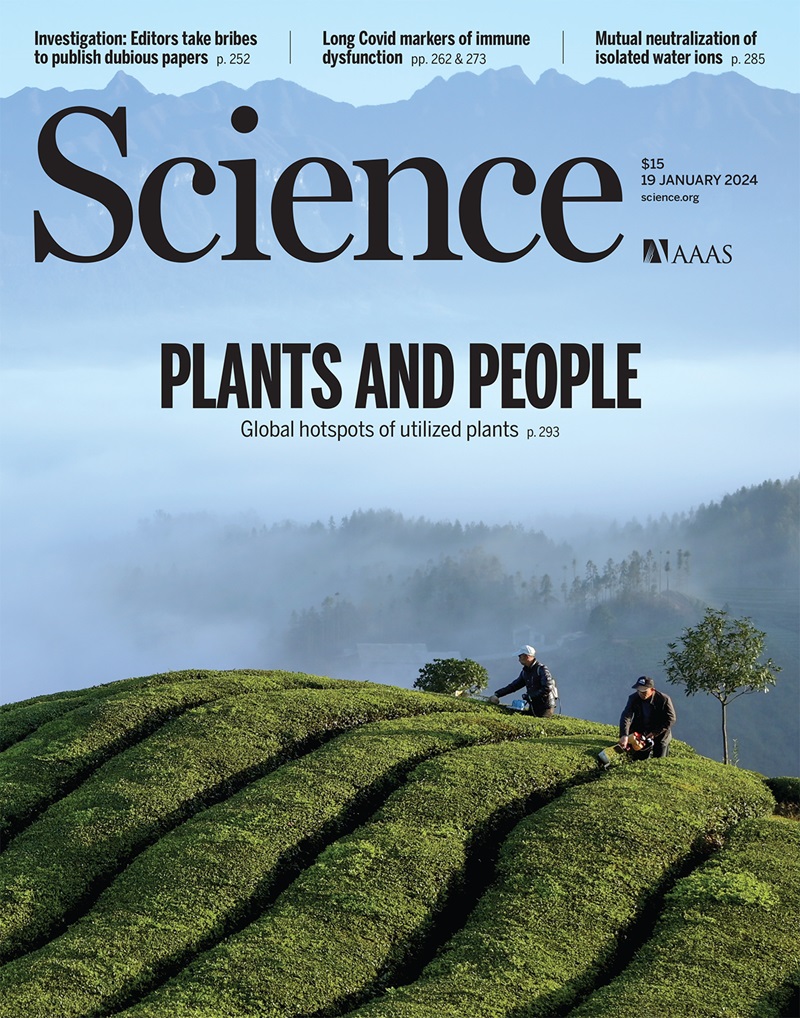晶圆级异质结构压电生物有机薄膜
IF 45.8
1区 综合性期刊
Q1 MULTIDISCIPLINARY SCIENCES
引用次数: 79
摘要
压电生物材料本质上适合在生物系统中耦合机械能和电能,以实现体内实时传感、驱动和发电。然而,无法大规模合成和排列压电相仍然是实际应用的一个障碍。我们提出了一种基于γ-甘氨酸晶体的晶圆级压电生物材料薄膜制造方法。这种薄膜具有三明治结构,其中甘氨酸结晶层在两层聚乙烯醇(PVA)薄膜之间自组装并自动排列。异质结构甘氨酸-PVA 薄膜的压电系数为 5.3 皮库仑/牛顿或 157.5 × 10-3 伏米/牛顿,与纯甘氨酸晶体相比,机械柔韧性提高了近一个数量级。甘氨酸-PVA 薄膜在生理环境中具有天然的兼容性和降解性,可用于开发瞬时植入式机电设备。本文章由计算机程序翻译,如有差异,请以英文原文为准。

Wafer-scale heterostructured piezoelectric bio-organic thin films
Piezoelectric biomaterials are intrinsically suitable for coupling mechanical and electrical energy in biological systems to achieve in vivo real-time sensing, actuation, and electricity generation. However, the inability to synthesize and align the piezoelectric phase at a large scale remains a roadblock toward practical applications. We present a wafer-scale approach to creating piezoelectric biomaterial thin films based on γ-glycine crystals. The thin film has a sandwich structure, where a crystalline glycine layer self-assembles and automatically aligns between two polyvinyl alcohol (PVA) thin films. The heterostructured glycine-PVA films exhibit piezoelectric coefficients of 5.3 picocoulombs per newton or 157.5 × 10−3 volt meters per newton and nearly an order of magnitude enhancement of the mechanical flexibility compared with pure glycine crystals. With its natural compatibility and degradability in physiological environments, glycine-PVA films may enable the development of transient implantable electromechanical devices.
求助全文
通过发布文献求助,成功后即可免费获取论文全文。
去求助
来源期刊

Science
综合性期刊-综合性期刊
CiteScore
61.10
自引率
0.90%
发文量
0
审稿时长
2.1 months
期刊介绍:
Science is a leading outlet for scientific news, commentary, and cutting-edge research. Through its print and online incarnations, Science reaches an estimated worldwide readership of more than one million. Science’s authorship is global too, and its articles consistently rank among the world's most cited research.
Science serves as a forum for discussion of important issues related to the advancement of science by publishing material on which a consensus has been reached as well as including the presentation of minority or conflicting points of view. Accordingly, all articles published in Science—including editorials, news and comment, and book reviews—are signed and reflect the individual views of the authors and not official points of view adopted by AAAS or the institutions with which the authors are affiliated.
Science seeks to publish those papers that are most influential in their fields or across fields and that will significantly advance scientific understanding. Selected papers should present novel and broadly important data, syntheses, or concepts. They should merit recognition by the wider scientific community and general public provided by publication in Science, beyond that provided by specialty journals. Science welcomes submissions from all fields of science and from any source. The editors are committed to the prompt evaluation and publication of submitted papers while upholding high standards that support reproducibility of published research. Science is published weekly; selected papers are published online ahead of print.
 求助内容:
求助内容: 应助结果提醒方式:
应助结果提醒方式:


